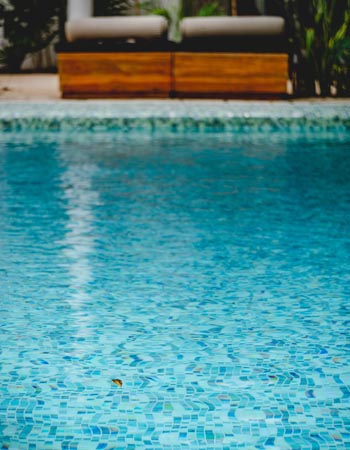

We may earn revenue from the products available on this page and participate in affiliate programs. Learn More ›
Highlights
- The typical range for pool liner replacement costs is $1,125 to $3,688 with a national average of $2,393.
- Pool type, size, and shape; liner type and design; labor; draining and refilling the pool; geographic location; and season can all impact the cost to replace a pool liner.
- Pool owners may need pool liner replacement if the pool is leaking or if the liner is dry or brittle, has holes or tears, has chemical damage, is stained, has lost its shape, or was installed improperly.
- Homeowners may be able to patch minor holes in a pool liner themselves, but liner replacement is a challenging job that is best left to a pool professional.
Pool liners are an important part of swimming pools that are made from non-waterproof materials, such as fiberglass, concrete, or gunite. A liner ensures the water stays in the pool and prevents mold and mildew growth. But a pool liner can bulge and tear with age, which can cause leaks and necessitate pool liner replacement. According to Angi and HomeAdvisor, pool liner replacement can range from $1,125 to $3,688, with homeowners spending $2,393 on average.
Some significant factors that influence pool liner replacement cost are whether the pool is an above-ground or inground pool, the size of the pool, and the thickness of the pool liner material. This guide will explore the factors in calculating pool liner replacement costs, telltale signs regarding when a pool liner needs to be replaced, and important questions for homeowners to ask a professional about pool liner replacement.
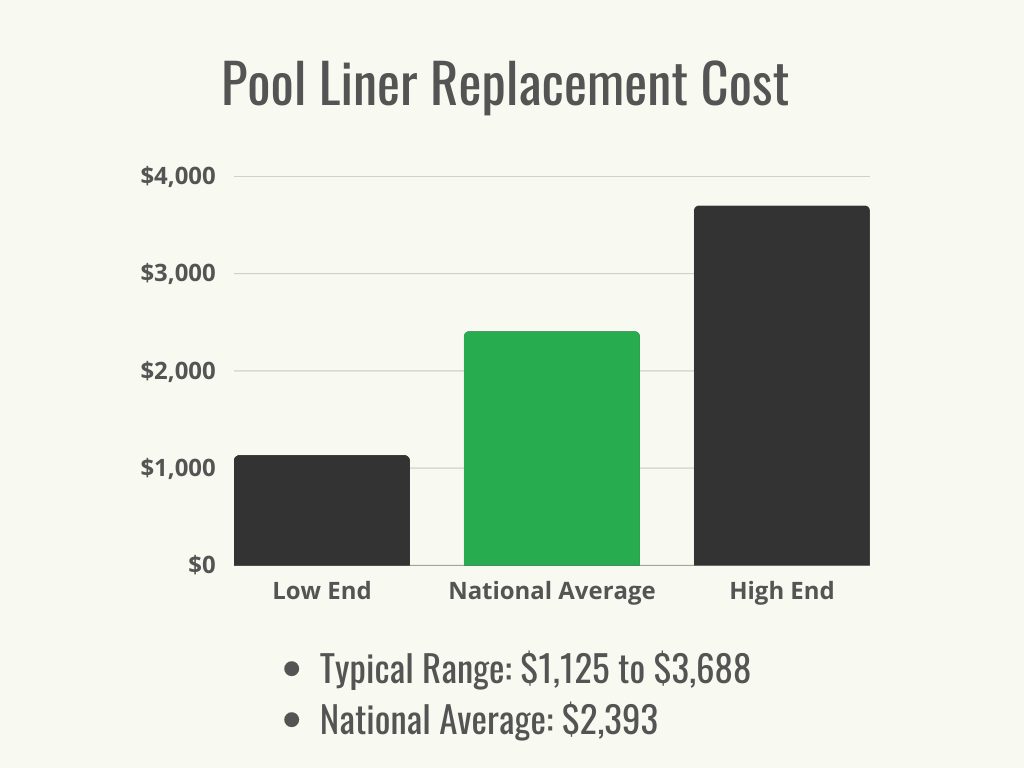
Key Cost Factors
How much is a new pool liner? That depends on several factors. Prices can differ from the national average because of the thickness and design of the liner material; labor costs; costs related to draining and refilling the pool; geographic location; the season; and the swimming pool type, size, and shape.
Pool Type, Size, and Shape
When estimating new pool liner costs, it’s important for homeowners to note that the differences in pricing for inground and above-ground pool liner replacement costs can be significant. Above-ground pool liner cost ranges from $100 to $600 for materials, plus $250 to $800 for installation. Inground pool liners cost between $700 and $1,500 for materials, with installation costs of $1,000 to $2,500. These prices can vary depending on liner material thickness and pool size and shape.
Replacing a liner in a larger pool will cost more than it would for a smaller pool. Pool liner replacement costs are typically less expensive for pools that have standard oval or rectangular shapes as opposed to those that are kidney-shaped or L-shaped. For example, the cost to replace a liner in a large rectangular pool may cost $2,950, but that cost will be higher for a more unusual shape. The chart below shows the cost to replace a pool liner based on pool size.

Liner Type
Above-ground vinyl pool liners usually come in three different types:
- Overlap liners. Typically the least expensive liner option, overlap liners are the easiest to install. This type of liner is draped over the entire pool, and clamps are used to keep it in place. Overlap liners rarely last as long as other liner options.
- Unibead liners. This versatile liner option creates a seamless look. Using a J-hook, it clips to the top of the pool wall.
- Beaded liners. These liners have a groove that will snap into a track along the top of the pool wall. These liners are considered easy to replace and repair.
Liner Thickness and Design
The answer to the question of how much does a new pool liner cost can greatly depend on the kind of liner a pool owner chooses. Pool liners are measured in mils. A mil is not a millimeter as the name might suggest; 1 mil equals 1/1,000th of an inch. A standard pool liner is 20 mil thick and typically lasts for 10 to 12 years. It’s recommended for homeowners to use a 28-mil-thick pool liner for pools that see heavy use. A standard liner may cost around $600, but a thicker liner can cost an average of $1,700, but it will last much longer than a thinner option. A thicker pool liner is less likely to rip or puncture, and it can camouflage an uneven pool floor. Vinyl pool liner replacement cost is also directly affected by the design of the liner. A liner with a solid color is typically less expensive than a liner that features a patterned design. Darker colors are also harder and more expensive to repair.
Labor
Some pool companies will provide an estimate that includes the price of labor and materials with the overall replacement cost. Service may start with a pool inspection to determine the problem, and a pool inspection costs $125 to $250. The average labor cost to replace an inground pool liner costs from $1,000 to $2,500, and the labor to install an above-ground pool liner ranges from $250 to $800.
Draining and Refilling
In order to replace a pool liner, the pool first needs to be drained. If a professional drains the pool, it can cost between $500 and $700. If city water is used to refill the pool, it can run from $60 to $120 on average.
Geographic Location and Season
Another important factor that affects the cost to replace vinyl pool liners is the home’s geographic location. The price of the liner, materials, and labor are usually more expensive in densely populated urban or suburban areas compared to more rural areas.
Pool professionals experience their busiest times during the spring and summer months, and they may charge more for their services during those times. Homeowners can also expect to wait longer for pool liner replacement during the busy months. To acquire more business during their slower months, pool professionals may charge significantly less during these times.
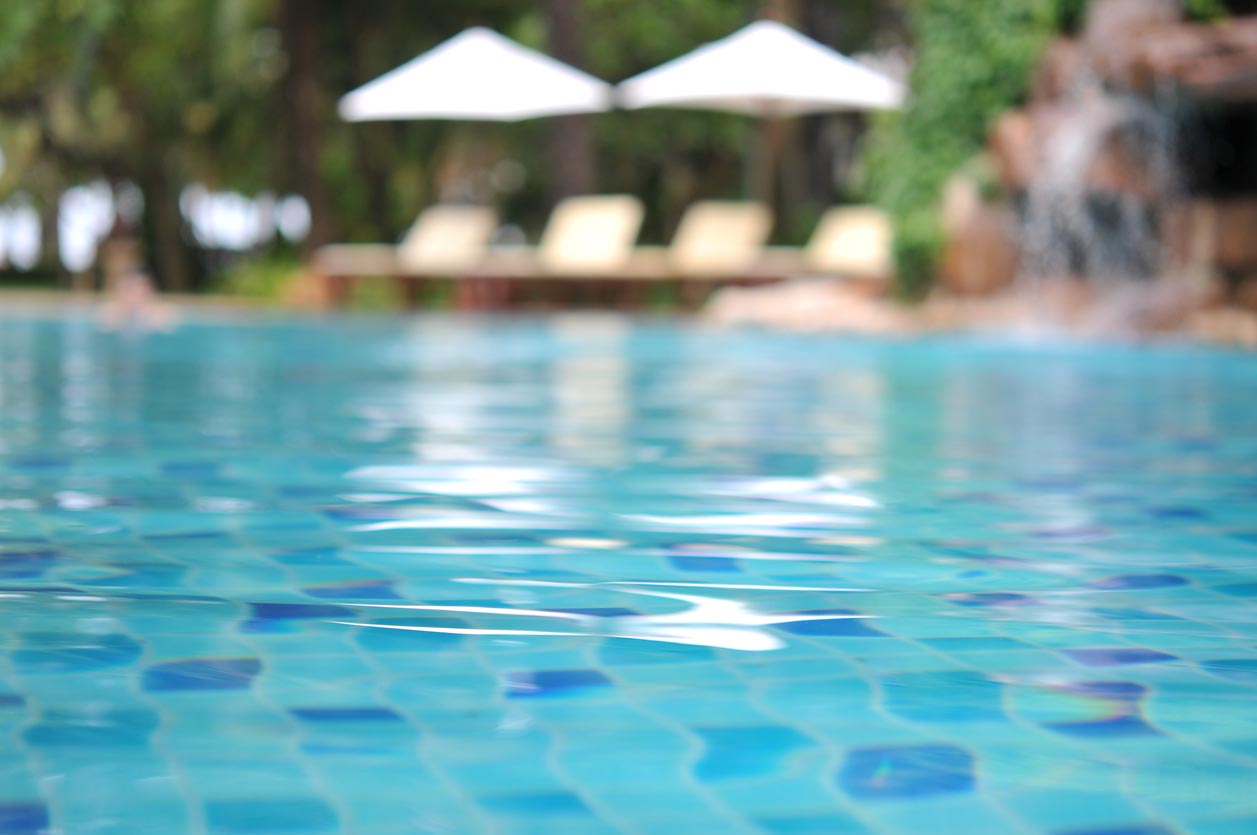
Additional Costs and Considerations
When budgeting for pool liner replacement costs, it’s important to know about any additional costs and considerations that may affect the overall price. These can include whether the pool liner needs to be replaced or if a repair will fix the problem.
Repair vs. Replacement
Hiring a professional to repair a vinyl pool liner can range in cost depending on the extent of the damage, pool type, materials, and labor. The average price of repairs can run from $100 to $350 or as high as $1,700 for more extensive repairs. For minor repairs, homeowners can also opt for one of the best pool patch kits that cost between $20 and $50. Some pool liners can be repaired rather than replaced. Below are some of the most common pool liner repairs and the average cost for each.
| Repair Type | Cost (Materials and Labor) |
| Bead replacement | $130 to $300 each (materials only) |
| Bulges | $30 to $50 or more (materials only) |
| Floor damage | $300 to $600 |
| Leak | Up to $2,500 |
| Sun damage | $530 for 150 linear feet |
| Tears, snags, and holes | $100 to $500 |
| Wrinkles | $100 to $250 |
- Bead replacement. If a bead cannot be pushed back into place in the track, it will cost from $130 to $300 for a new bead.
- Bulges. Wintertime groundwater freeze-thaw cycles and subflooring shifts can cause bulges in the pool liner. Some options for homeowners to consider to repair a liner bulge are to pump out the water from behind the bulge or drain the pool and cut out the bulged section of the liner. In this case, patching this section will cost $30 to $50. For significant bulge issues, a liner replacement may be necessary.
- Floor damage. Repairing floor damage to an above-ground pool is an extensive process. The pool needs to be drained, and a professional needs to determine whether the leak is coming from the liner or the pool structure. Once the leak is located, the pricing is determined by the cause of the problem. Pool resurfacing costs $6,500 and is one possible solution. Other floor damage repairs cost between $300 and $600.
- Leaks. Depending on the severity of the leak, a repair can cost up to $2,500. If the repair price is that high, many homeowners will choose to replace the liner instead.
- Sun damage. A pool liner can be damaged by UV rays and when the temperature is above 80 degrees. To protect against sun damage, homeowners can cover the pool during the day when it’s not being used.
- Tears, snags, and holes. Patching holes in a pool liner can run from $100 to $500, depending on the type and extent of the damage.
- Wrinkles. Pool liner wrinkles are common with improper installation, extreme temperatures, incorrect chemical balance, or a sudden decrease in water level. Repairing wrinkles can cost from $100 to $250, but if they’re significant, the liner may need to be reinstalled.
Warranty
While many pool warranties last 20 to 30 years, full coverage may only apply for the first 2 to 5 years. After this point, coverage may only extend to a certain percentage of repair or replacement costs. A warranty is also likely to cover materials only. Some homeowners get coverage for their pool on their home warranties. Getting one of the best home warranties for pool coverage, such as one from Choice Home Warranty or American Home Shield, can fill in any gaps that are not covered by the manufacturer’s warranty, although it’s important for homeowners to note that they will still be responsible for a service fee of about $60 to $150 if they need to make a claim.
Types of Pool Liners
How much is a pool liner? Above-ground and inground pool liner replacement cost is affected by the type of liner used for the pool as well as the type of pool. The costs to replace a pool liner on a fiberglass or a vinyl pool are discussed below.
| Liner Type | Cost (Materials and Labor) |
| Fiberglass | $1,500 to $5,000 |
| Vinyl | $100 to $1,600 |
Fiberglass
An alternative to vinyl pool liners, fiberglass is long-lasting, durable, and resists mold and mildew growth. Depending on the shape and size of the pool, homeowners can expect to pay from $1,500 to $5,000 for a fiberglass liner. Minor repairs to a fiberglass liner can average approximately $300 to $400.
Another option is to budget for fiberglass pool costs, although this type of pool typically costs more to install than a vinyl-lined inground pool. Fiberglass pools use less electricity and can even increase the resale value of a home.
Vinyl
Above-ground vinyl pool liners usually run from $100 to $700, with installation costs between $175 to $250 on average. For an inground pool, a vinyl liner replacement ranges from $800 to $1,600 for materials and an additional $1,100 to $2,600 for installation. Cost ranges for both inground and above-ground liners are dependent on the thickness of the liner. While thicker liners can be significantly more expensive up front, they can provide savings in the long run since they won’t need to be replaced as frequently.
Do I need a pool liner replacement?
Vinyl pool liners typically last from 5 to 10 years, and fiberglass lasts as long as 25 to 30 years, as long as a homeowner knows how to maintain their pool properly or hires a swimming pool maintenance service. Sometimes a repair is the best choice to prolong the life of the liner, but there are telltale signs when a liner needs to be replaced. If homeowners notice any of the following issues with a pool liner, there’s a good chance a new liner is needed. Waiting too long to replace a pool liner can cause expensive pool floor and wall damage as well as deck deterioration from water erosion.
Leaking Pool
Minor leaks can usually be repaired, but severe leaks can cause damage to the pool subfloor, which can cause it to crack. A cracked subfloor will need to be redone. Leaks can also cause the metal walls to rust, which will affect the structural integrity of the pool.
Dry or Brittle Liner
As a pool liner gets older, it can become brittle and crack. Newer liners can be easily repaired, but if the material is dry and fragile, it becomes difficult to repair and a new liner is the only option.
Large Holes or Tears
Large holes or tears in the soft vinyl material are more difficult to repair than smaller ones. If the hole is too big to be repaired, a full pool liner replacement is needed.
Chemical Damage
The incorrect chemical pH in the water can cause the pool liner to wrinkle and break down faster than usual, which will result in the need for liner replacement sooner than expected.
Staining or Discoloration
Staining or discoloration of a pool liner occurs when it’s exposed to harmful UV rays and when the pool chemicals aren’t properly balanced. Algae growth and rust can also discolor and stain the liner and are difficult to remove. When this happens, some homeowners opt to replace the liner for aesthetic reasons.
Loss of Shape
A pool liner can stretch out and lose its shape as it gets older. Bumps, wrinkling, and the liner popping out of its track can happen when the liner stretches out. If the liner keeps coming out of its track, water can leak behind the liner and cause issues with the structure of the pool.
Improper Installation
A pool liner that’s improperly installed can wrinkle or cause damage to the bead tracks. If the liner doesn’t lay against the floor and walls correctly, it can rip and cause extensive damage.
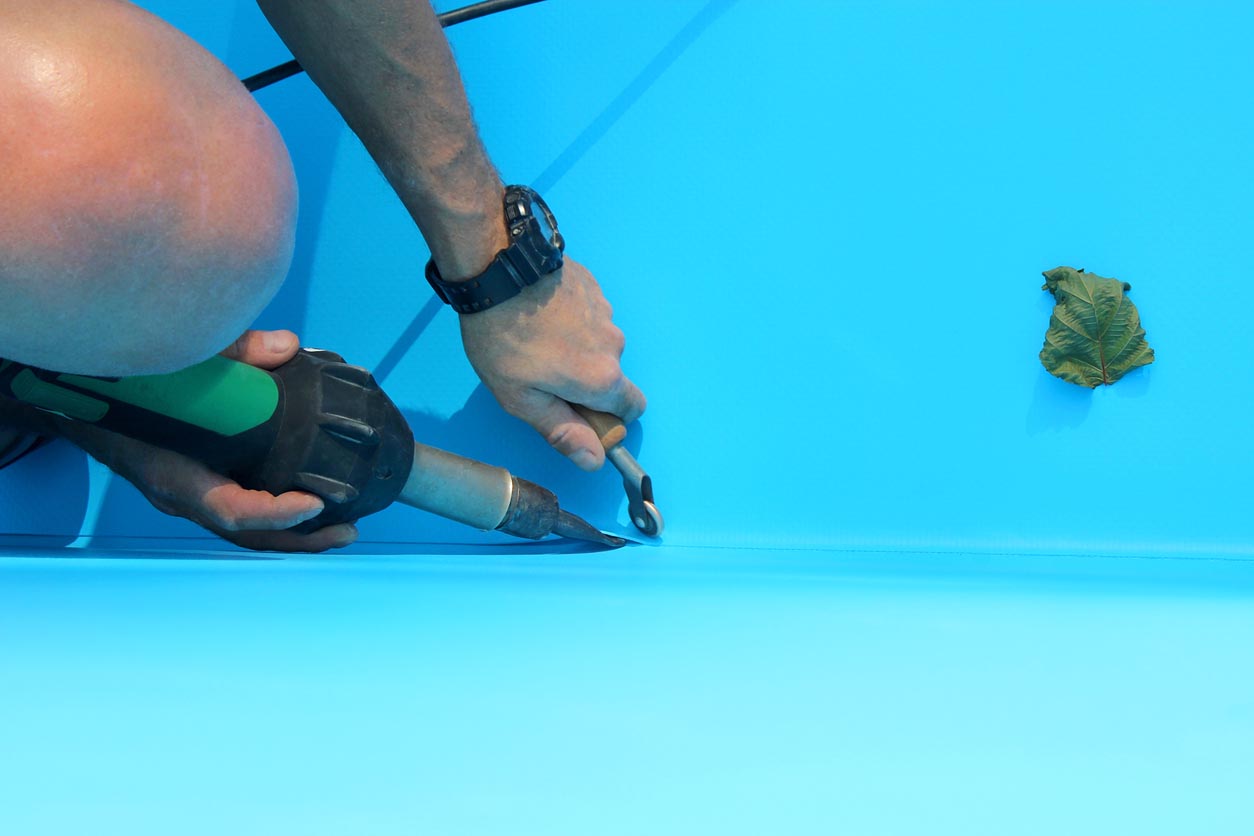
DIY vs. Hiring a Professional
Just like learning how to build a pool, installing a pool liner takes extensive skill and expertise. If a homeowner has experience with pool liner repairs or if it’s a quick fix above the waterline, a DIY repair may be the way to go. It may also be simple to learn how to replace an above-ground pool liner compared to an inground one. But incorrect liner installation can lead to wrinkles and tears, which will cost even more money to repair or replace. While hiring a pool professional to install a pool liner is more expensive than a DIY project, homeowners will want to keep in mind that a professional has the experience to install a liner correctly. Some pool liner companies will also void the warranty if it’s installed as a DIY project. Homeowners who are unsure of the exact problem, don’t have the experience, or need a full liner replacement will want to hire a pro. A professional will know how to deal with any problem that arises during the installation process, and they can make the pool look like new. While pool liner installation costs are not trivial, the cost of fixing a botched installation will be much higher—a homeowner may even be looking at paying additional above-ground pool costs or inground pool costs to reinstall or resurface their existing pool.
How to Save Money
Budgeting for the cost of a new pool liner can be challenging, and the additional fees associated with the project can quickly add up. The following tips can help you save money without compromising on quality.
- Get multiple quotes. Get quotes from at least three reputable pool professionals in your area.
- Choose a plain liner. A liner with a patterned design or a deep color is much more expensive than a traditional sky-blue liner.
- Be flexible. Pool companies are busiest during the spring and early summer months. If you can schedule a pool liner replacement during their slow time, you may be able to save money.
- Be proactive. Cover the pool when it’s not in use, keep the chemical levels balanced, and repair small tears as quickly as possible. Budgeting for pool maintenance costs can prevent large problems.
- Get a high-quality liner. While it will result in a higher up-front cost to build a pool, a high-quality liner will last longer and be more resistant to tears.
- Establish a regular cleaning routine. Removing debris and cleaning the pool regularly to remove sunscreen residue and algae buildup can extend the life of the pool liner. Consider hiring one of the best pool cleaning services if this chore feels overwhelming.
Questions to Ask a Pro
Asking a pool professional the right questions about pool liner replacement can minimize miscommunication and help homeowners find the right professional for the job. The questions listed below are designed for a homeowner to ask some of the best pool installation companies or pool repair companies as part of their research.
- How many years have you been in business?
- How much does it cost to replace a pool liner?
- Are you insured?
- Will you provide references?
- Does the estimate include labor?
- How long will it take to install the pool liner?
- Who will install the liner?
- Can the existing liner be repaired?
- Are you a member of the Association of Pool and Spa Professionals (APSP)?
- Do you have workers’ compensation insurance?
- What type of warranty do you offer on your work?
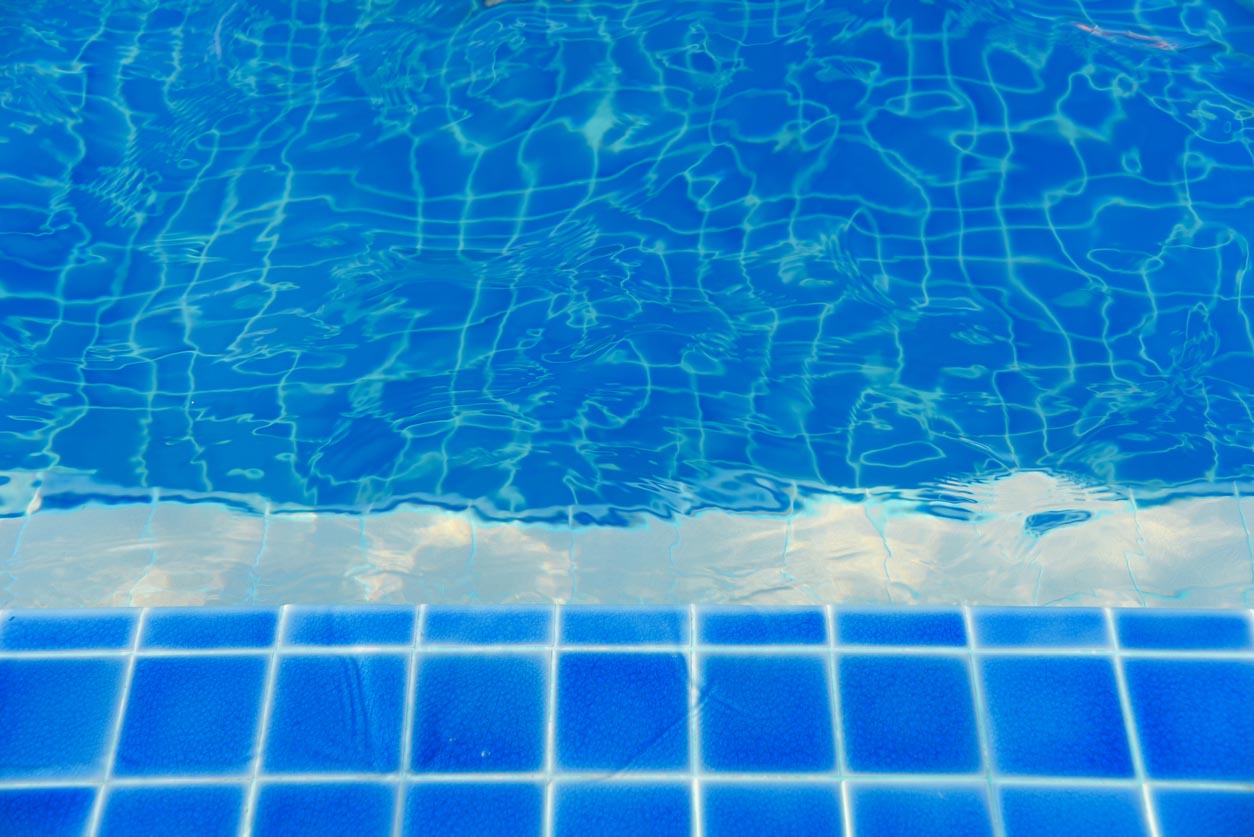
FAQs
The process of replacing a pool liner can result in multiple questions. Below are a few frequently asked questions about pool liner replacement to help homeowners find the best professional for the job.
Pool liners typically last between 15 and 20 years, though some fiberglass liners can last as long as 50 years.
A deep-blue liner is the most popular, although light blue is another popular option since it doesn’t readily show signs of fading.
One isn’t necessarily better than the other, and the choice comes down to preference. Some advantages of a darker color are that it hides imperfections and dirt, it absorbs heat better, and it can save on energy costs. A lighter liner color can result in a cooler water temperature, create a beachy vibe, and can be printed with a darker pattern for more contrast.
Pool liners can slip if the bead track opens up, which can happen with water pressure or an aging liner.
It is not recommended to put a new liner over an old one since it can cause more problems. If there are holes and tears in the old liner, it can cause structural damage to the pool when water gets in between the two layers. Since it’s common to refinish the pool floor when replacing the liner, that can’t be done if the old liner is left in place.
Angi, HomeAdvisor, HomeGuide
